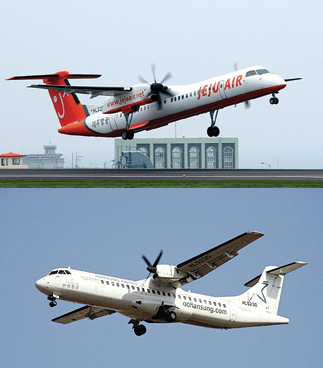Red ink, regulations challenge Jeju Air

The president of Jeju Air, one of the country’s two budget airlines, told reporters at a ceremony yesterday that the company intends to fly to Asian countries such as Japan and China beginning in 2010. It would fly earlier, Joo Sang-kil said, but the Transportation Ministry recently introduced a rule requiring startup airlines to wait at least three years to fly internationally. Only two Korean carriers, Korean Air and Asiana, have that right now.
“We cannot accept the Ministry of Construction and Transportation’s disapproval,” Joo said, according to a release. “If the government continues to reject our plans, we will consider taking legal action.”
An official from the International Air Transport Division at the ministry who declined to be named said the rule is designed to protect passengers. “The government should consider airline carriers’ safety, convenience, capital level and experience before allowing them to run international flights,” the official said. “That requires a minimum period of three years, as seen from cases in other countries.”
The money issue could be a problem. Jeju Air posted a deficit of 14.1 billion won ($15.2 million) last year and forecasts a deficit of half that amount for this year.
Jeju Air was set up on June 9 of last year with an initial investment of 40 billion won ($43.1 million) and five turboprop planes.
Cho Byong-hee, an analyst with Kiwoom.com Securities, said low-budget airlines will have a hard time making big profits by running only domestic routes.
“Budget carriers in foreign countries with bigger land areas and a larger number of domestic destinations ― the United States, for instance ― can turn profits. But not here.”
In addition, he said, “not many Korean tourists bound for destinations abroad would be willing to stand for low-quality in-flight services.”
According to industry data, low-fare carriers in the United States such as Southwest Airlines and JetBlue now account for almost 25 percent of the market, while their market share is 15 percent in Europe. In Asia, the figure is only 3 percent.
Hansung Airlines, with a focus on Chungcheong Province, was Korea’s first budget airline. It started in 2005.
Three more low-budget carriers are set to start as soon as early next year ― Yeongnam Air, running between Busan and Daegu, Jeonbuk Air and another to be launched by the Incheon city government.
By Seo Ji-eun Staff Writer [spring@joongang.co.kr]










with the Korea JoongAng Daily
To write comments, please log in to one of the accounts.
Standards Board Policy (0/250자)